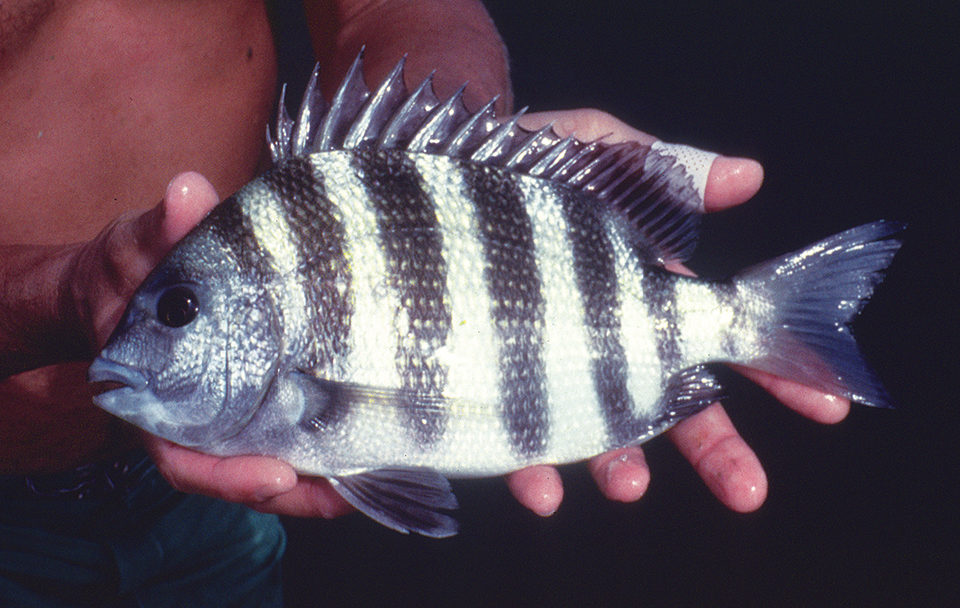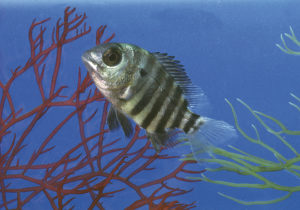Robust, cheap-to-feed fish that can be grown variety of environments

Sheepshead (Archosargus probatocephalus), of the family Sparidae, is an excellent food fish that ranges from Nova Scotia, Canada, to Brazil in mainland coastal waters, rivers and freshwater springs. It can reach a maximum size in nature of more than 14 kg and 90 cm, and an age of 20 years or more, but one as large as 66 kg has been reported.
In the United States, sheepshead is not a heavily targeted species and has limited commercial availability, but sometimes sheepshead is substituted for red snapper and other more expensive fish in restaurants. In the United States, the recreational fishery is larger than the commercial one, constituting nearly 90 percent of the total catch in the state of Florida.
Fishing gear for sheepshead, in order of usage, includs castnets, hook and line, trawl, spear or gig, seine and trap. Sheepshead often are caught by part-time fishermen and sold in small numbers. When and where they were legal, gill nets and trammel nets were very productive. During the last few years, whole sheepshead weighing 1.0-2.5 kg sold for U.S. $4 to 5/kg wholesale ($9 retail) in east central Florida.
Sparids such as red seabream in the Far East and gilthead seabream in the Mediterranean are well established in aquaculture, and others have potential, including the sheepshead. To reach 450 grams, red sea bream need about 16 months and gilthead sea bream about 14 months, but sheepshead need only nine to 11 months.
Sheepshead are robust fish that are cheap to feed and can be grown out in ponds, cages, tanks or raceways in saltwater or hard freshwater. They probably are one of the toughest species in the seabream family and in some ways could be considered a model. Juveniles and adults have tough scales and are very difficult to injure. They are less bothered by handling than most other fish and are very resistant to infections and parasites.
Spawning and larviculture
Sheepshead spawning is relatively easy, and all stages are hardy. Wild sheepshead mature by an age of 2 years and weight of 350 to 400 grams. Along the southeastern U.S. coast, they spawn mostly during February to June.
The author has induced ovulation with human chorionic gonadotropin (HCG), followed by strip spawning or voluntary fertilization in the broodfish tank. At 23 to 26 degrees-C, females with initial oocyte diameters of 400 µm that were given one or two intramuscular injections of 1,000 I.U0./kg HCG ovulated 75 to 77 hours after the first injection.
Considering their adaptability and the ease of inducing spawning, sheepshead probably will spawn voluntarily like many other sparids. Strip spawning of a ripe 367-gram male and 398-gram female caught during April 1984 produced more than 15,000 eggs. Larger females can release 100,000 eggs at a time.
Sheepshead spawn at about 23 degrees, and the optimal temperature range for larvae and juveniles is about 23 to 28 degrees-C. Larvae can survive at 22-33 degrees, while juveniles can survive at 10-35 degrees or higher, and sometimes can survive at as low as 5 degrees-C. Once larvae are 2-3 weeks old, they can tolerate transfer to freshwater. Juveniles can survive in salinities of 0-44 ppt or more. The author has grown them out in fresh- and saltwater ponds and held them in saltwater cages.
At about 23 degrees-C, sheepshead hatch in approximately 28 hours at 1.6 mm long. They first feed three days after hatching, exhaust their yolk and oil in four days and transform into juveniles in about 39 days. They can reach a mean weight of 500 grams in a year and 1.5 to 2.0 kg in two years.
Rearing study
In the first complete rearing study in 1984, sheepshead were raised in 1,000-liter and 3,500-liter greenwater tanks on a diverse diet of rotifers, artemia, copepods, scallop and shrimp meals, and crab larvae. Commercial salmon starter was first given on day 27. As a precaution, live food was continued until day 48, then tapered off by day 70, but weaning could have been accomplished much sooner.
Six thousand 100-day-old, 70-mm juveniles were produced from one spawn, with a hatchery tank density of 1.5 fish per liter at 67 days. From fertilization to day 7, survival was 62 percent. Then through 100 days, it was 64 percent with no further mortality of tank-reared fish for more than three years.
Feed

In a preliminary trial, sheepshead initially weighing 220 grams had better growth rates and conversion on salmon feed than trout or catfish feed, or fresh food. Because the fish had been transferred from 0.014-ha ponds to 2.4-meter-diameter tanks, aggressive encounters from the sudden increased crowding caused feed wastage and elevated activity, leading to inflated feed-conversion ratios for all the foods. Like many other warmwater marine fish, sheepshead are certain to grow faster and more efficiently on diets formulated for them.
Because juvenile and adult sheepshead are omnivorous, compound feeds would be relatively economical and easy to formulate. By 50 days, fully developed juveniles had the cutting and crushing dentition typical of adults and readily ate raw and cooked chicken liver and beef heart, frozen spinach, fresh seaweeds, and several commercial feeds. From that time onward, they kept macroalgae growing on the tank walls well cropped.
Wild early juveniles eat copepods, ostracods, amphipods, mysid shrimp, polychaetes and bryozoans. Late juvenile to adult sheepshead (200 mm or longer) eat bivalves, tunicates, starfish, macroalgae, shrimp, amphipods, snails, crabs, sponges, polychaetes, bryozoans, barnacles, seagrasses and small fish if they are slow enough. The flavor of sheepshead varies with their habitat and diet, and can be controlled.
Culture potential
With more research and rising value, sheepshead could become a very good candidate for aquaculture. The main impediment is its present low value, but sheepshead farming could be economically feasible if demand and prices rise. A steadier supply and marketing could help this happen. Sheepshead are not well known at a distance from the harvest areas, but several years ago they were ranked highly in a foreign fish show held in Japan.
Spawning and rearing techniques could be refined and made more efficient. As with some other territorial omnivorous fish, aggression among juveniles is a potential problem that can be controlled by proper management. If raised in cages, sheepshead eat fouling organisms and help keep the cages clean. In that capacity, they could be polycultured with carnivorous fish of similar size as harvestable cage cleaners.
(Editor’s Note: This article was originally published in the March/April 2008 print edition of the Global Aquaculture Advocate.)
Now that you've finished reading the article ...
… we hope you’ll consider supporting our mission to document the evolution of the global aquaculture industry and share our vast network of contributors’ expansive knowledge every week.
By becoming a Global Seafood Alliance member, you’re ensuring that all of the pre-competitive work we do through member benefits, resources and events can continue. Individual membership costs just $50 a year. GSA individual and corporate members receive complimentary access to a series of GOAL virtual events beginning in April. Join now.
Not a GSA member? Join us.
Author
-
John W. Tucker, Jr., Ph.D.
St. Lucie County Mosquito Control District
3150 Will Fee Road
Fort Pierce, Florida 34982 USA
Tagged With
Related Posts

Aquafeeds
A look at phospholipids in aquafeeds
Phospholipids are the major constituents of cell membranes and are vital to the normal function of every cell and organ. The inclusion of phospholipids in aquafeeds ensures increased growth, better survival and stress resistance, and prevention of skeletal deformities of larval and juvenile stages of fish and shellfish species.

Health & Welfare
A study of Zoea-2 Syndrome in hatcheries in India, part 2
Indian shrimp hatcheries have experienced larval mortality in the zoea-2 stage, with molt deterioration and resulting in heavy mortality. Authors considered biotic and abiotic factors. Part 2 describes results of their study.

Health & Welfare
A study of Zoea-2 Syndrome in hatcheries in India, part 3
In this third and final part, authors present recommendations to help reduce the incidence of Zoea-2 Syndrome, which is not caused by any known infectious agents in P. vannamei hatcheries in India.

Aquafeeds
ASAIM addresses challenges to growth of marine fish farming in Southeast Asia
In its efforts to advance sustainable aquaculture practices and the use of soy-based feeds in Southeast Asia, the American Soybean Association International Marketing Program (USAIM) has identified several challenges.


